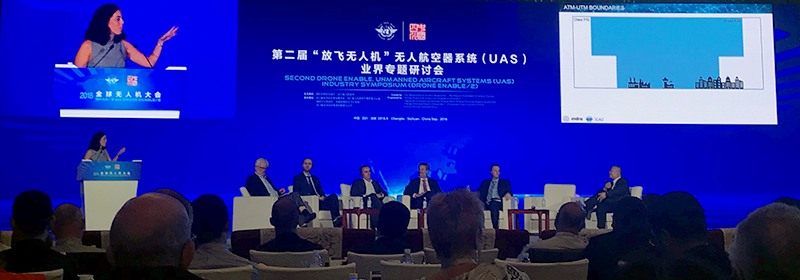- Its proposal has been selected by the ICAO from among fifty studies for having “one of the best approaches to address the problem”
- The company has put forward their vision at the Drone Enable 2 Symposium in China, which gathered the global aviation industry
- Solving this challenge is essential for the development of the business of using drones for professional or recreational purposes, which will generate more than €10 billion a year in Europe alone

At the Drone Enable 2 Symposium recently held by the International Civil Aviation Organization (ICAO) in Chengdu (China), Indra presented its vision about how to address the challenge posed by the integration of conventional air traffic, complex and congested as it is, with the large number of drones of all types that are expected to arrive in cities and occupy the airspace in the coming years.
This is a challenge of huge proportions for which authorities, the industry and service providers are urgently looking for an answer. Its resolution will not only have an impact on aviation security, an absolute priority for the aviation sector, but also on the development of a thriving business that in Europe alone will generate €10 billion in 2035 (SESAR European Drones Outlook Study, 2016), an hefty figure that is merely the starting point for this new sector.
Indra’s proposal, presented in Chengdu by engineer Patricia Hervías, was selected a few months ago from among fifty responses sent by companies, research centers and countries from all over the world.
After carefully analyzing all of them, the ICAO, the UN agency that studies aviation problems to promote common regulations and norms of general acceptance throughout the world, considered that the vision of Indra Technology is “one of the best approaches to address the problem” from an “unconventional approach.”
For the company, the increasing number of drones with professional or recreational uses will make specific drone traffic control systems indispensable in the short term, systems known in the sector as Unmanned Traffic Management (UTM).
These systems will monitor, regulate access to airspace and verify that autonomous aircrafts or aircrafts controlled by pilots in land follow their flight plans, adhere to air space regulations or conflict with another device.
The following step will be to address the integration of UTM systems with those currently used for conventional air traffic management (ATM systems).
Although in the first phase both systems will be developed independently, it will soon be necessary to gradually increase the exchange of information between them, until full integration is achieved. According to the vision proposed by Indra, this will be a process divided in four phases that will come to conclusion when both types of aircrafts operate without restrictions in the same space.
Airports and cities will be two of the most sensitive areas for the coexistence of manned and unmanned aircrafts, given their critical nature for security. Areas struck by catastrophes or emergencies will also require special attention, given that a great number of drones and conventional aircrafts will operate there indiscriminately, performing dangerous tasks, sometimes in low-visibility conditions, such as during the extinguishing of large fires or rescues at sea.
In order to guarantee the protection of critical infrastructures, official buildings or military installations, it will be necessary to have advanced anti-drone systems capable of detecting the presence of UAVs in restricted flight zones and take the adequate measures to counteract them.
For Indra, ensuring the safety of aerial drone operations is key to being able to harness all the economic and job-creating potential this sector will contribute.
Indra is in an unbeatable position to provide an answer to the problem. It is a leading company in the development of air traffic technology that it has introduced in 160 countries. This gives it a privileged global view of the problem and possible solutions. At the same time, it is a company that is developing its own family of drones of different types. Furthermore, it works within the Civil UAVs Initiative promoted by the Xunta de Galicia in one of the most ambitious projects launched in Europe to promote the development of civilian drones that improve the services provided to the citizen by the Administration.
About Indra
Indra is one of the leading global technology and consulting companies and the technological partner for core business operations of its customers world-wide. It is a world-leader in providing proprietary solutions in specific segments in Transport and Defence markets, and the leading firm in Digital Transformation Consultancy and Information Technologies in Spain and Latin America through its affiliate Minsait. Its business model is based on a comprehensive range of proprietary products, with a high-value focus and with a high innovation component. In the 2017 financial year, Indra achieved revenue of €3.011 billion, with 40,000 employees, a local presence in 46 countries and business operations in over 140 countries.